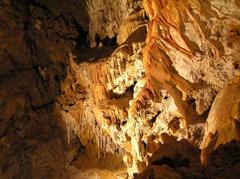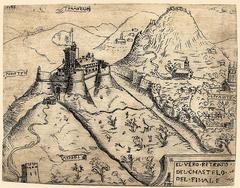Monumento Ai Caduti Finale Ligure: Comprehensive Visiting Guide, History, and Preservation
Date: 14/06/2025
Introduction
The Monumento Ai Caduti in Finale Ligure is a poignant symbol of remembrance, honoring local soldiers who lost their lives during World War I, World War II, and other major conflicts of the 20th century. Strategically situated in the districts of Finalpia and Finalmarina, this memorial stands as a testament to the community’s resilience, unity, and enduring respect for its history. The monument’s architectural and cultural significance, combined with its accessibility and integration into the urban landscape, make it a must-visit for history enthusiasts and travelers exploring Finale Ligure’s rich heritage (Monumento ai Caduti (Finalpia, Finale Ligure) - Wikimedia Commons, Pietre della Memoria).
This guide provides an in-depth look at the monument’s origins, design, role in community life, visitor information, preservation efforts, and how to integrate it into a broader Finale Ligure itinerary.
Table of Contents
- Origins and Historical Context
- Architectural Features and Symbolism
- Role in Local and National Memory
- Preservation and Community Engagement
- Visitor Information: Hours, Tickets, Accessibility
- Integrating the Monument into Your Itinerary
- FAQ
- Visual Gallery
- Conclusion and Visit Tips
- Sources
Origins and Historical Context
Erected in the aftermath of World War I, the Monumento Ai Caduti in Finale Ligure was commissioned by the local municipality as part of Italy’s national movement to honor its war dead. The initiative reflected collective mourning and pride, with funding sourced from public subscriptions and municipal support. The monument’s location in Finalpia, a historic district, was chosen to anchor public memory within the heart of community life, and its unveiling was an event attended by dignitaries, veterans, and families of the fallen (Monumento ai Caduti (Finalpia, Finale Ligure) - Wikimedia Commons).
Architectural Features and Symbolism
The monument seamlessly blends neoclassical motifs with local artistic traditions. Its core elements include:
- Two-Stepped Stone Base and Plinth: Symbolizing the ascent from earth to the spiritual realm, the base is inscribed with the names of local citizens who fell in both world wars, using durable marble to ensure lasting remembrance (Pietre della Memoria).
- Fluted Column with Doric Capital: Rising from the plinth, the column represents strength and continuity, while the Doric capital imparts solemnity.
- Bronze Eagle: Perched atop the column, the eagle’s outstretched wings symbolize courage, vigilance, and national pride.
- Bronze Torch: At the base, a torch signifies eternal memory and enlightenment.
- Enclosure with Pilastrini and Chains: Small stone pillars linked by chains create a sacred, enclosed space for reflection.
- Garden Setting: Landscaping enhances tranquility and separation from the urban environment.
Each sculptural and architectural detail is imbued with meaning, from the vertical ascent evoking spiritual elevation, to the eagle and torch, which embody resilience and remembrance.
Role in Local and National Memory
The monument is a living memorial, central to Finale Ligure’s communal identity. It is the site of annual commemorations, such as Liberation Day (April 25th) and National Unity and Armed Forces Day (November 4th), where citizens, veterans, and officials gather to lay wreaths and honor the fallen. Local schools organize educational visits, instilling historical awareness in younger generations and reinforcing the importance of remembrance (Comune di Finale Ligure - Eventi).
Preservation and Community Engagement
Ongoing Maintenance and Restoration
Preservation is a joint effort involving municipal authorities, heritage organizations, and engaged citizens. The monument is subject to natural weathering from the maritime climate and occasional acts of vandalism, such as the incident in April 2025 that damaged several stone columns and prompted swift restoration (104News). Maintenance includes cleaning, stonework repairs, and landscaping.
Community and Digital Initiatives
Local groups advocate for the monument’s care, organizing volunteer efforts and reporting issues via social media and news platforms. These collaborations ensure timely responses to maintenance needs and foster a shared sense of guardianship over this important landmark (AlbengaCorsara).
Institutional Collaboration and Future Plans
The Comune di Finale Ligure works with regional heritage agencies and restoration experts, focusing on sustainability, improved interpretive signage, and enhanced accessibility for all visitors (Visit Finale Ligure).
Visitor Information: Hours, Tickets, Accessibility
- Location: Centrally located in Finalpia and Finalmarina, easily reached by foot, public transport, or car (parking available nearby).
- Visiting Hours: Open year-round, from dawn to dusk (typically 8:00 AM to 7:00 PM). No specific opening or closing times; accessible during daylight.
- Admission: Free; no tickets required.
- Accessibility: Wheelchair-accessible walkways and plazas. Benches and shaded areas are provided for rest.
- Interpretive Signage: Information is primarily in Italian, with some English translations.
- Photography: Permitted; visitors are asked to be respectful, especially during ceremonies.
For current events or guided tours, consult the official tourism portal or local tourism offices.
Integrating the Monument into Your Itinerary
The Monumento Ai Caduti is ideally located for inclusion in a broader exploration of Finale Ligure:
- Morning: Start at the monument, then explore the medieval streets of Finalborgo, visit the Basilica di San Giovanni Battista, or the Archaeological Museum.
- Midday: Enjoy the seaside promenade (Lungomare Migliorini) and visit the related Monumento ai Caduti del Mare (Wanderlog).
- Afternoon: Hike or bike the scenic nearby trails, or relax on the town’s award-winning beaches.
- Evening: Experience local dining, events, and festivals (Comune di Finale Ligure - Eventi).
Public amenities, ATMs, and cafés are readily accessible in the area.
FAQ
Q: What are the Monumento Ai Caduti visiting hours?
A: The monument is open year-round during daylight hours, typically from 8:00 AM to 7:00 PM.
Q: Is there an entrance fee or ticket required?
A: No, visiting is free and does not require a ticket.
Q: Is the site wheelchair accessible?
A: Yes, with paved paths and accessible plazas.
Q: Are guided tours available?
A: Occasionally, especially during commemorative events or via local tourism offices.
Q: What nearby attractions can I visit?
A: Basilica di San Giovanni Battista, Finalborgo, Arco di Margherita di Spagna, and the seaside promenade.
Q: Can I take photographs?
A: Yes, but please be respectful, especially during ceremonies.
Visual Gallery

Monumento Ai Caduti, Finalpia. Photo: Wikimedia Commons

Detail symbolizing Victory and Peace. Photo: Wikimedia Commons
Conclusion and Visit Tips
The Monumento Ai Caduti stands as a profound testament to Finale Ligure’s historical legacy, civic values, and ongoing commitment to remembrance. Its architectural elegance, rich symbolism, and central location make it an essential stop for anyone interested in Italian history or cultural heritage. The monument’s preservation is a shared endeavor, reflecting the town’s dedication to honoring its past and educating future generations (Comune di Finale Ligure - Eventi, 104News).
For an enriched experience, download the Audiala app for self-guided tours, interactive maps, and up-to-date event information, and follow local news and tourism portals for preservation updates and community events.
Sources
- Monumento ai Caduti (Finalpia, Finale Ligure) - Wikimedia Commons
- Pietre della Memoria: Monumento ai Caduti di Finale Ligure
- Comune di Finale Ligure - Eventi
- Visit Finale Ligure
- 104News: Finale Ligure Danneggiato il Monumento ai Caduti di Piazzetta Libertà
- AlbengaCorsara
- Wanderlog

